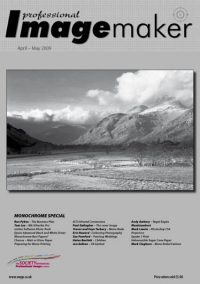articles/Paper/paperformonochrome-page1
Which is the best paper for monochrome photos? - part 1 of 1 2
by Mike McNamee Published 01/04/2009
"we are blessed with an array of top-class papers..."
This is an agonisingly difficult choice to make. The reason for the pain is simple; we are blessed with an array of top-class papers and every photographer will have their favourite, although very few will have the time, opportunity, or inclination to test more than a handful. At Professional Imagemaker we have now tested something like 1,000 printer/paper combinations - that's our job! When trying to decide upon a paper you have to work your way through a number of options and find your way down through a family tree of the characteristics. Here is our attempt at describing the questions you need to answer.
First you have to decide on your printer, (should you have more than one?) which will also govern the maximum print size.
Then decide between matt or not matt surfaces - hence MK or PK inkset.
Decide if you are prepared to tolerate OBAs in your media.
Decide upon textured, smooth, lustre, or canvas as your surface finish.
Decide if you want 100% cotton rag or an alpha cellulose base.
Decide upon the paper caliper
Decide upon the paper weight. Fine Art Trade Guild demand 250gsm minimum for example. Some printers have a limit on paper thickness.
Decide upon sheet or roll stock (or even board).
Decide upon ABW printing (Epson only) or 'colour' or CIS
Blacks - based on Dmax, metamerism, etc.
The one thing you should not do is be seduced by the print before you, and allow the 'content' of the image to determine your choice. Just because you are looking at a magnificent Paul Gallagher print does not mean that his paper/ printer/workflow choice is right for you. Your work might be fundamentally different and fundamentally unsuited to his approach. On the other hand the quality of his prints may show you just how much depth you can invoke in an inkjet print!
The other thing you should avoid is making side-byside comparisons of matt and gloss/lustre prints. The two types are so fundamentally different that matt will always look a little 'flat' alongside its flashy, high-Dmax cousin. However, if you allow the matt image to stand alone (and never show a client both) it can import wonderful subtlety to the viewer. It is highly unlikely that an image file prepared for a gloss paper will print perfectly to a matt paper especially in the deeper tones.
The slightest tendency to over-saturate the matt paper with too much ink can bring unexpected and unpleasant surprises; a light touch may be needed. If you imagine that such finesse can be achieved with profiling and instruments you may be in for a shock. It is far more likely that you will have to make proof copies and experiment. One advantage of inkjet over silver halide is that you can anticipate much greater print-to-print consistency. Providing you archive the correct file and keep notes about the settings, it is most likely that you will be able to produce identical prints for some time after the first-offs.
You are currently on page 1
- Which is the best paper for monochrome photos? page 1
- Which is the best paper for monochrome photos? page 2
1st Published 01/04/2009
last update 09/12/2022 14:57:20
More Paper Articles
There are 17 days to get ready for The Society of Photographers Convention and Trade Show at The Novotel London West, Hammersmith ...
which starts on Wednesday 14th January 2026





